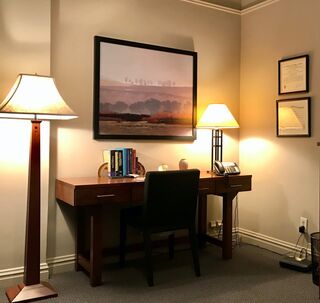Persuasion
Returning to the Office in the Midst of the COVID Pandemic
Remembering what enlivens the practice of psychotherapy.
Posted November 10, 2020

I heard the voices of two patients in my head while my plane was circling LaGuardia for a landing. I had been away from New York for seven months, seeing patients via telepsychiatry, and was returning for a short visit and to see several patients in person.
One patient, a health care professional, had plaintively asked, “when am I going to get to see you in the office again?” He added, “You should see New York now; with all the sidewalk cafes, it’s like Paris." The other, a businessman who prides himself on forecasting economic and social trends, said, “You shouldn’t think about coming back to the city; it’s too dangerous."
I was perplexed that two well-informed patients could offer such differing assessments about the effect of COVID on daily life. I wondered if returning to my office might help me understand their perspectives and, in the bigger picture, appreciate how my practice of psychotherapy had been altered by seven months of remote sessions. Knowing that I would return to telepsychiatry after the visit, I was concerned about how I would continue to address the ongoing mental health effects of COVID as the pandemic continued, worsened, and eventually waned.
Something was missing from my psychotherapy work. I had in mind the work of Jerome Frank, who, in his landmark book, Persuasion and Healing, wrote about healing relationships across cultures and identified common elements of effective interventions. Frank highlighted the sanctified space in which the healer practiced and the helpful belief among sufferers that the healer knew something that they didn’t know about human nature and the world we inhabit.
Frank had primed me to understand that in the West, a sanctified space means the psychotherapist’s office with its décor of books and diplomas and just enough of a personal touch to reveal something of the therapist’s private life. These elements communicate knowledge, comfort, and warmth that promote the therapeutic alliance.
What Frank didn’t articulate, and which surprised me during my stint of seeing patients in person, was how much richer and even more joyful it was compared with conducting sessions remotely. Surely this counts towards the patient’s therapeutic experience and helpfulness of treatment.
Freed from the confines of a computer screen, I could take in and reciprocate the animating gesticulations of one patient and shift to in-person doctoring when another patient developed a nosebleed. All of this was enlivening in a way I had forgotten about during months of telepsychiatry. Those patients who chose to come into the office expressed their gratitude for my seeing them in person despite reminders of COVID risk in the session such as wearing a mask, sitting eight feet apart, hearing a HEPA filter humming in the background, and reviewing a lengthy safety protocol that was required of patients before the office visit.
Being together in the office was perhaps even more important in light of the second component of healing that Frank identified and COVID has undermined. The sense that the therapist has an intelligible and coherent view of the world inducts a patient into treatment and sustains hope that psychotherapy will relieve suffering. But at this time of COVID menace and not unrelated political turmoil, it has become more difficult to differentiate realistic versus unrealistic worries about the future that awaits us.
Sitting with patients seemed helpful to convey that I shared the psychological space of not knowing what the forecast of a COVID “dark winter” will mean. The best I can offer is the unspoken, “we’ll get through this together," unlike empirically tested interventions for obsessive-compulsive disorder or post-traumatic stress disorder where the therapist has a working model of what constitutes excessive worry and what to do about it. Even with promising early data from the Pfizer vaccine trial, there is no treatment manual to guide us about when we will be able to return to Carnegie Hall or Shea Stadium without masks, let alone hug those we’ve missed seeing. What we do have is Anthony Fauci’s wise but ambiguous advice to “softly go into a graded degree of normality."
Being back in my office made a dent in these imponderables and provided answers to the questions I had about being a practitioner of telepsychiatry. I hadn’t experienced the extent to which I, too, was grieving COVID losses, in my case for the pleasure of seeing patients in person and for missing the surround of my office rich with decades of memories and mementos of professional life.
For many psychotherapists, COVID will continue to require us to be more remote with patients than we would like and will tax our abilities to help them discern what are reasonable worries. Jerome Frank thought demoralization was the common currency of those seeking relief from psychic distress and this seems an apt description of not knowing how to plan for next month, next year, or perhaps longer during this time of COVID. Nearly 60 years after the publication of Persuasion and Healing, what’s different now is that therapists seem to be in the same boat as their patients in trying to achieve a balance between caution and a fuller resumption of life during times that are, at times, not particularly intelligible.
To find a therapist, please visit the Psychology Today Therapy Directory.
References
Frank, J. (1961). Persuasion and Healing. Baltimore, John Hopkins Press




